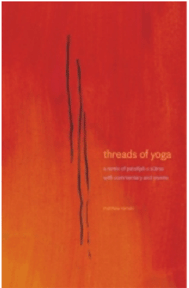a remix of patanjali’s yoga sutras, with commentary and reverie
Author: Matthew Remski
Reviewer: Bernie Clark, September 13th, 2014
 My partner was reading quietly beside me one evening, occasionally chuckling, exclaiming out loud comments like “wow!” “right,” and “that’s so interesting.” After a while she paused, closed her book halfway and told me, “You have to read this.” Nathalie is a meditation teacher first and foremost, she is also a yoga teacher and an ardent student of Ayurveda, and I value her advice, but when I saw that she was reading a book about the Yoga Sutra, I groaned inwardly and thought, “not another book about Patanjali.” I declined her invitation, at least initially. Fortunately, a few weeks later, I picked up her book, which she cleverly left lying on our coffee table. After scanning a few lines, I was hooked.
My partner was reading quietly beside me one evening, occasionally chuckling, exclaiming out loud comments like “wow!” “right,” and “that’s so interesting.” After a while she paused, closed her book halfway and told me, “You have to read this.” Nathalie is a meditation teacher first and foremost, she is also a yoga teacher and an ardent student of Ayurveda, and I value her advice, but when I saw that she was reading a book about the Yoga Sutra, I groaned inwardly and thought, “not another book about Patanjali.” I declined her invitation, at least initially. Fortunately, a few weeks later, I picked up her book, which she cleverly left lying on our coffee table. After scanning a few lines, I was hooked.
Remski’s book is unlike any version of the Yoga Sutra you will have come across. It is neither a translation, nor an interpretation of this 1,700-year-oldpsycho-spiritual manual, but rather, as Remski himself says, a remix. One problem I have with treatments of old texts is that authors tend to ignore the reality that the text was written for an older time, a now non-existent audience, and within a culture long passed. Without the original context, it is impossible to understand the true teaching being offered. These old maps do not serve us very well today. Often modern writers will simply extract passages that fit their personal worldview, while ignoring all the other passages that definitely don’t fit. Or they will bend the words and change them beyond recognition into flowery, poetic endorsements of their spiritual philosophies. Remski doesn’t buy into any of that, he is very upfront about what is missing in the ancient ascetic practices prescribed by Patanjali, shows us where he believes Patanjali fails us today, but also where he can still be relevant. Here is one small sampling of the flavour of this exposition:
“Patanjali says little about the value of embodied sensation. He says little about interpersonal love, and nothing of children or ecology. He presents an ultimately internalizing path, in which ethics are a means towards social disentanglement, and the body has evolutionary value to the extent we are disgusted by it (sutra 2.40). In other words, he teaches exactly against the present zeitgeist of yoga culture. And yet his book is presented, largely uncritically, as a seminal text in most yoga education programmes throughout the world today.”
The ancient map described by Patanjali and others was definitely anti-body, and in those days, suffering the conditions they had to live with, through and under, that may have been a skillful philosophy for a few people to adopt. But it certainly is not skillful for us today. We need better maps.
threads of yoga is a modern version of what Patanjali attempted two millennia ago. It addresses the same themes of suffering and its ending, of ignorance and its causes, of practice and its fruition, but it is done within the modern context of what science and psychology has learned, and it includes rather than dismisses the physical. Where the original sutra is impenetrable and for the most part unusable by modern Western souls, Remski’s remix is very accessible and applicable to all of us. This is a valuable book, one all serious students of yoga and fans of the Yoga Sutra should read, in fact – if you had to read only one book about the Yoga Sutra, this would be the one, and I am glad that Nathalie left it on the coffee table for so long.
You can learn more about the threads of yoga on Matthew Remski’s own website.
